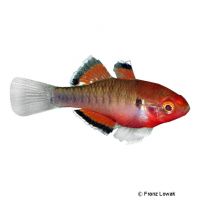Empire Gudgeon (Hypseleotris compressa)
| Empire Gudgeon Hypseleotris compressa | |
|---|---|
| Name | Empire Gudgeon |
| Name Lat. | Hypseleotris compressa |
| Synonym | Eleotris compressus |
| Family | Bully Sleepers |
| Family lat. | Eleotridae |
| Order | Gobies |
| Order lat. | Gobiiformes |
| Origin | Australia, New Guinea |
| Habitat | Streams, rivers |
| Diet | Carnivore |
| pH | 5.0-9.0 |
| Behavior | Peaceful |
| Keeping | Group |
| Care Level | Easy |
| Reproduction | Substrate spawner |
| Breeding | Difficult |
| Life Span | 5-8 years |
| Protection | No |
| Metric Units | |
| Size | 10-11 cm |
| Temperature | 20-30 °C |
| Hardness | 2-25 °dH |
| Aquarium | 80 cm / 100 l |
| US Units | |
| Size | 3.9"-4.3" |
| Temperature | 68-86 °F |
| Hardness | 36-445 ppm |
| Aquarium | 25 gal |
Distribution and habitat
The Australian carping gobies are found in the north of Australia as well as in the south of New Guinea. There they live in the oceanic lower reaches of rivers and streams with dense underwater vegetation and deadwood, where they often swarm in the current under floating plants and foliage protruding into the water.
Maintenance
The aquarium should have a dense border planting, with numerous hiding places (roots, stones) and provide sufficient swimming space. A fine-grained substrate covered with some foliage (e.g. sea almond tree), shaded light (floating plants) and medium-hard water with a moderate current is ideal.
No ammonia, ammonium and nitrite should be detectable, the nitrate value should not exceed 100 mg/l. To ensure the water quality and oxygen content, a filter and heater adapted to the aquarium size is required, as well as lighting for the species-appropriate day-night rhythm of the animals.
Diet
In the wild they feed mainly on insect larvae, small crustaceans and shrimp. The food supply consists of live or frozen cyclops, daphnia, bosmids, artemia, mosquito larvae, etc. or a commercially available frozen special food mix. Dry food (granules, flakes) is also usually well accepted, but should not be the main component of the diet
Only as much should be fed as is eaten immediately (in a maximum of 10 minutes). A regular and varied diet promotes health and increases resistance.
Behaviour and compatibility
These peaceful and somewhat shy fish should be maintained in a group of at least 5 individuals. The bright red males during the spawning season occupy small territories, which are defended against other males. A socialization with other peaceful fish, like rainbowfish and spikefish, but also with tetras, rasboras, armored catfish etc. is well possible. Basically, only compatible fish species with similar demands on water condition and water temperature may be socialized.
Sex dimorphism
The males are much more colorful and especially during courtship intensely colored red to orange-red. The females are less high-backed and not so intensely colored.
Reproduction and breeding
There are isolated reports of successful breeding in the aquarium. The female lays up to 3000 tiny eggs on a flat stone, shell or root. The clutch is guarded by the male. After about 24 hours the larvae hatch and drift with the current of rivers and streams into the sea, where they feed on the finest marine plankton. After their pelagic development in the sea, they return to freshwater and swim back upstream in the small streams and rivers.
Important
Australian carping gobies are not bottom oriented, but swim in open water.
If there are several males in group keeping, they compete with each other and at least one mating male shows himself in the most beautiful colorfulness
The well-being of the fish should be checked regularly. The temperature should be checked daily, the pH, hardness and nitrate value at least every 14 days. A regular partial water change is recommended, even if the pollutant load has not yet reached the upper limit. Sudden changes in water quality should be avoided. Newly introduced fish must be accustomed slowly to the water in the aquarium.
Further literature can be found in your pet store.
References
Text: Werner Winter; Image: Franz Lowak
Source: BMELV (1998): Tierschutzgutachten - Haltung von Zierfischen (Süßwasser); BAENSCH & RIEHL (2004): Aquarien Atlas Bd. 2, Mergus Verlag; ENGELMANN (2005): Zootierhaltung - Tiere in menschlicher Obhut: Fische, Verlag Harri Deutsch
- Gemäß § 21 Abs. 5 Tierschutzgesetz idgF
